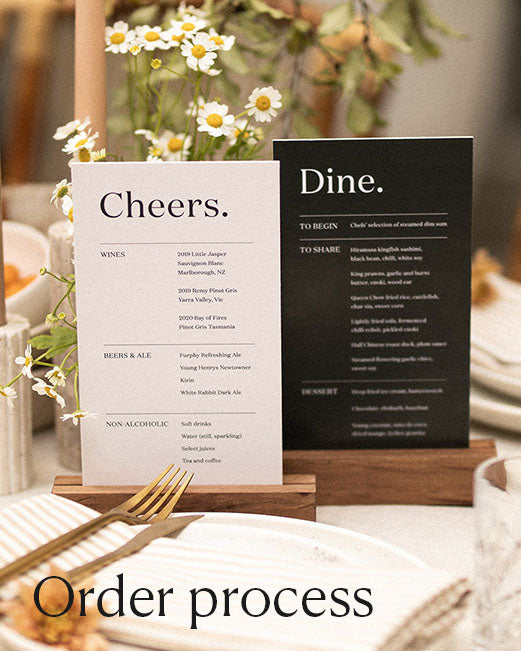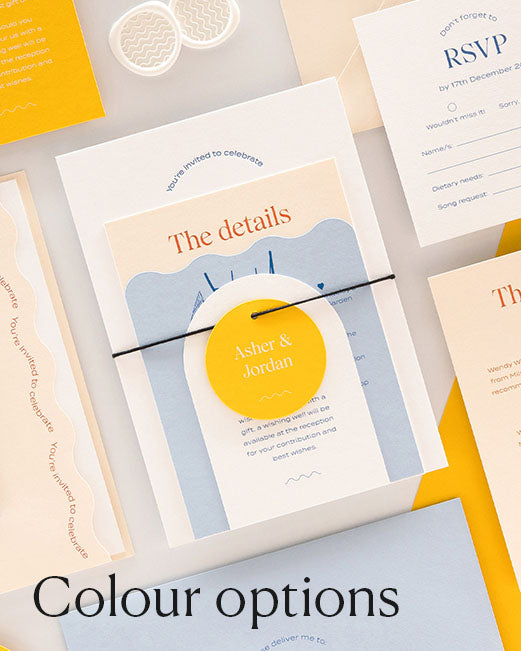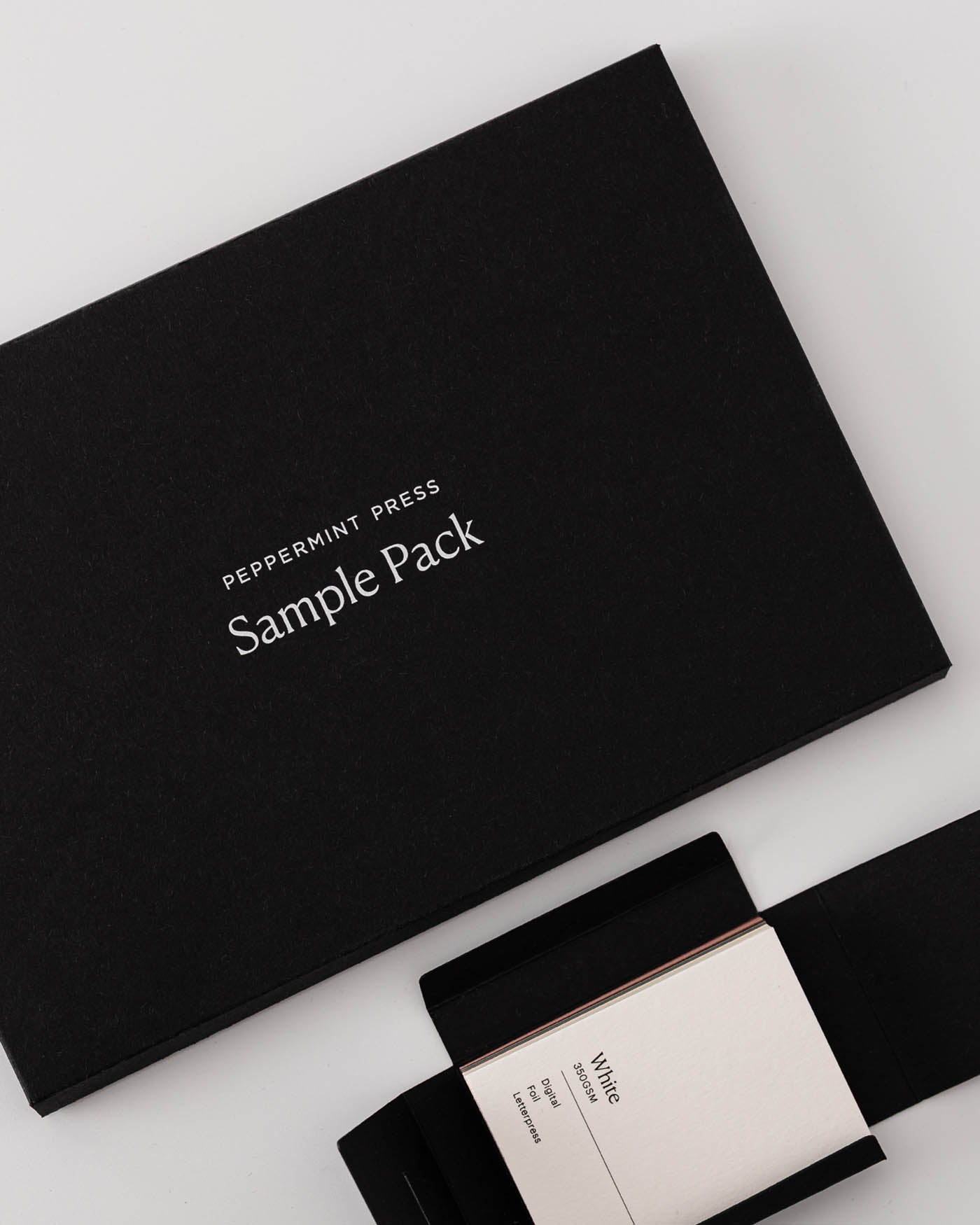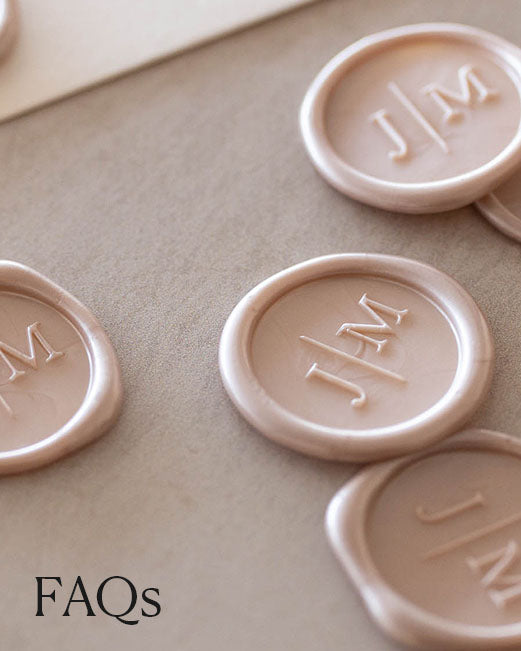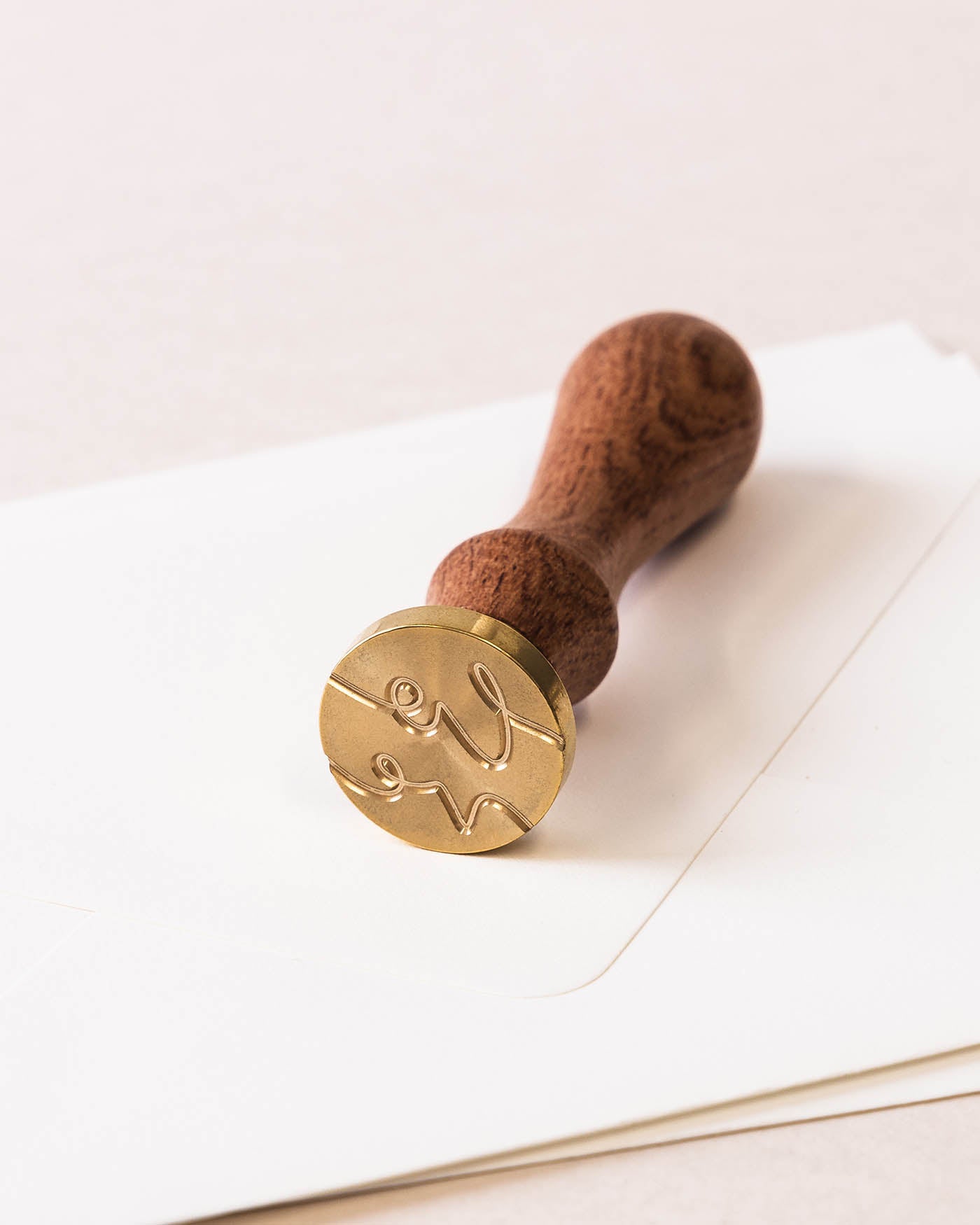Couples often focus on finding the perfect design and enhancing the visual appeal of their wedding invitations. However, the wording you use deserves equal thought. In fact, the wording and the design of your invitations should work together to show off your style and present you as a couple. From the traditional must-haves to the optional extras, in this article we cover all things words and help you decide how to word wedding invitations.
Harnessing the power of words in wedding invitations
Words possess immense power. They're capable of shaping thoughts, influencing emotions, uplifting, inspiring as well as connecting with people on a deeper level. Think of this when wording your wedding invitations. If you take the time to carefully arrange your words to reflect the tone, emotion and level of formality you'd like to convey to guests, you'll end up with the perfect base upon which to grow your wedding plans.
When shopping for wedding invitations, you'll find that most designs will already have default or pre-set wording (like our own collections at Peppermint Press). However, with our own invitations - as well as those of other wedding stationery suppliers - you can adapt your wording to reflect your own personality, style and wedding.
Hoping for a beautifully traditional invite? Or perhaps hoping to swap the formalities for a casual tone? If you're wondering how to word wedding invitations in your own way, you'll want to get informed.
In this article, we help you to learn a little about what is typically included in an invitation; the contents, the associated traditions and the options you have to make your invitations your own. Where we can, we offer some wording advice and examples too.

Style: traditional vs. modern
Like most things wedding-related, when it comes to invitations there is tradition tied to all details large and small. Whether you adopt these traditions is truly up to you.
Traditional invitations tend to use formal and traditional language, maintaining a sense of sophistication. Modern invitations, on the other hand, often use more conversational language, setting a relaxed and approachable tone.
Here's a little more information about one of the most important differences between traditional and modern wedding invitations:
Traditional
Traditionally, if parents are hosting (aka paying for) the wedding, their names will go at the top of the invitation asking or requesting the guests to attend their son or daughter's wedding. In these cases, the parent’s full names are typically included, with the couple's names last.
Normally, the bride’s parents are mentioned first – but names can also be listed in alphabetical order. In this instance, it would be considered normal that the last names of the bride and groom are omitted.
While this format might seem super formal, many couples and their parents appreciate the inclusion and mentions – especially if the parents are helping to foot the bill. What's more, this more traditional format is also an opportunity for family members and friends to be informally introduced to the in-laws.
Here's an example of a more traditional format.
Modern
Should the couple be hosting or paying for the wedding themselves (or should they have agreed with parents that their names shall be the sole focus of the invitations) this traditional format can be flipped.
In this case, the couple’s full names are mentioned, requesting the guest’s presence followed by a line similar to “together with their parents”, without mentioning their parents’ full names or potentially even omitting their parents’ names altogether.
Here's an example of a more modern format.

1. The invitation itself
Now that you've considered an important wedding invite tradition, it's time to focus on your wedding invitation card. Remember, that how you choose to word your wedding invitations is up to you - as long as the pertinent details are included, they can be written in a tone or language that’s truly reflective of you as a couple.
Here's the information that's typically included on a wedding invitation card:
Hosts
Begin by stating who is hosting the wedding. Traditionally, it would be the bride's parents, but in modern times, it can be the couple themselves, both sets of parents, or even other family members (as explained above).
Request line
Following the hosts' names, include a line that requests the presence of the guests. For example, "Request the honour of your presence" for a religious ceremony or simple "Invite you to celebrate" for a more casual event.
Whilst this example could be considered quite formal, this one is friendly and this one very common.
Couple's names
Clearly state the names of the couple getting married. Traditionally, the bride's name precedes the groom's name, but you can choose the order that feels right for you.
Date and time
Clearly indicate the date, including the day of the week, along with the time of the ceremony.
Venue
Next, include the name and address of the wedding ceremony and reception venues. If the reception is at a different location, mention it separately.
Attire
Provide a dress code suggestion if desired, such as "Black Tie," "Cocktail Attire," or "Casual Dress" and get guests excited about their outfits!

2. RSVP card
Like wedding invites, RSVP cards have also evolved over the years, with couples even taking requests for songs or late-night snacks in addition to confirmation of attendance. However, typically an RSVP card includes the following elements:
RSVP request
Begin the card with a polite request for a response. Common phrases include "Kindly RSVP," "Please Respond," or "RSVP Requested."
Response options
Provide pre-determined response options for guests to choose from. The most common options are "Accepts with pleasure" and "Regretfully declines." You can also include additional options like "Might attend" or "Will let you know."
Names of guests
Leave space for guests to write their names and the number of attendees. This allows you to keep track of who will be joining you on your special day.
Acceptance or decline line
Include a line where guests can indicate their attendance by checking a box or filling in a blank space. It's also helpful to include a deadline date for responses.
Meal preferences
If you are offering meal options, you can include a section where guests can indicate their preferences (e.g., beef, chicken, vegetarian).
Find a simple RSVP example here, as well as a minimalistic one, and a more playful one here.

3. Location card
A location card is a very simple insert in your wedding invitation package and has one clear purpose; to help people get to your venue. At Peppermint Press, locations cards are embellished with beautiful yet handy maps. However, additional written words on a location card can include:
Venue names and addresses
Clearly state the names of the ceremony and reception venues. Include the full addresses of both venues, including street name, city, state, and ZIP code. This ensures that guests can easily locate the venues using GPS or navigation services.
Date and time
Restate the date and time of the wedding ceremony and reception to provide a reminder for guests.
Directions and maps
At Peppermint Press, location cards include beautiful hand drawn illustrations which depict your wedding venue's location. Including a visual element to your invitations gives your suite a more appealing and diverse look, however it can also be decorated with wording (address, times, dates, directions, venue names), to make it as helpful as possible.

4. Note on gifts card
Whether you're encouraging gifts, directing people to a registry or requesting wishing well donations, it's important that you get your 'note on gifts' just right. Many couples like to keep this small card insert lighthearted, whilst also revealing their gratefulness to guests. You could select or write a poem or simply write a heartfelt sentence or two - the choice is up to you!
Gift information
If you've signed up with a gift, then including information about the shop or website where you have registered is important. Provide clear details such as the name of the registry, the stores or websites where it is available, and any necessary codes or instructions for accessing it. Otherwise, if you're welcoming gifts of any kind, your note on gifts can be short and sweet. You might like to note that it is polite, humble and also typical to phrase your note on gifts in a format such as this:
"Your attendance at our wedding is truly the greatest gift we could ask for. However, if you'd like to bring us a gift to help us start the next chapter of our new lives together, we will be providing a gifts table at our reception".
Wishing well
A wishing well is a box at your wedding which is used to collect cash from those guests who would like to contribute to your honeymoon, your home or your new life together. Typically, couples will use playful poems, heartfelt notes or otherwise just instructions in order to help guests understand how their wishing well works and what it is used for.
Please refer to our helpful guide on wishing well wording here.

5. The details
An information card is a component of a wedding invitation suite that provides additional information about the wedding. So if you've got some details that haven't managed to make their way to the invitation card, this is the place to drop them.
Information cards can also be the place to respectfully tell your guests if your reception is adults only, for example, and may also share information on any cultural elements that will take place on your wedding day.
You probably won't have too much space to provide this information to guests, so keep things short and sweet and where possible factual to avoid filing your card with too many words. The more concise, the better!
You could include the following information on your location card:
Parking information
Specific parking arrangements or restrictions at the venues should be mentioned in your information card to inform guests about the available parking options, whether it's on-site parking, nearby parking lots, or street parking. Mention any parking fees or validation processes, if relevant.
Accommodation suggestions
If you have reserved a block of rooms at nearby hotels or have specific accommodation recommendations, you can mention them on the location card. Include the hotel names, addresses, contact information, and any booking codes if applicable.
Transportation information
Whether or not you're providing transportation services for guests is an important detail to include in your invitations. If you're putting on shuttle buses or transportation from the ceremony to the reception, mention the details on the location card. Include the pickup/drop-off points and the schedule, if applicable.
The next day
Do you have plans for the next day? Maybe a fun mid-morning brunch or a picnic? Let your guests know what the schedule is and provide them with any details they need for the day following your wedding.
Take a look at this detailed information card as well as this one which keeps things short and sweet.

6. Envelopes
Now that you have the inside covered, it's time to focus on your envelopes. Here's a bit of background information on the traditions associated with wedding invite envelopes and their addressing.
When your invitation is being sent to a married couple with the same name it’s traditional to write Mr. and Mrs. John and Jane Smith. When the couple has different last names, you would write both their full names.
When addressing a couple who isn’t married you write their names individually, with Miss. and Mr. if you choose to go super traditional, or just their names. This goes for same-sex couples too.
If you are inviting a family, it’s etiquette to write the parents’ full names and just the first names of their children.
For your friends or family who you’re allowing to have a plus one, but may not know who their date will be, address the invitation to the individual only, but indicate in the RSVP card a space for their guest’s name.
Remember, how you address your invitation, can also be totally customisable! Many couples forego traditional titles and will only write first and last names - and that's totally fine!
Envelope addressing
Save time and your hands by having us print your guest names and return address on your envelopes. Available in standard or white ink depending on your envelope colour, envelope printing adds a stylish arrival for your guests to receive their stationery. Learn more here.
Premium wedding invitations with Peppermint Press
Invitations with Peppermint Press are created surrounding our beautiful design collections. Diverse in their style, our invitations are all printed onto high quality card and are designed by professional designers.
Click here to browse our timeless wedding invitation packages.

